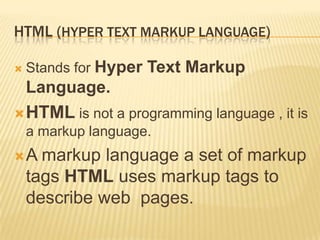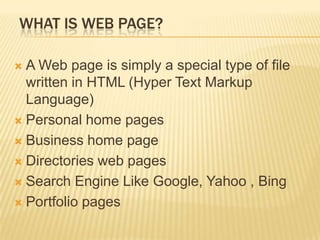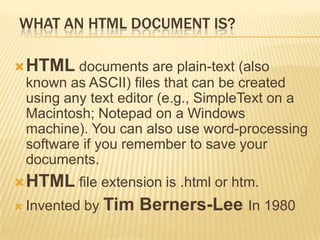An Introduction to HTML
- 1. HTML HYPER TEXT MARKUP LANGUAGE
- 2. HTML (HYPER TEXT MARKUP LANGUAGE) ’āÆ Stands for Hyper Text Markup Language. ’āÆ HTML is not a programming language , it is a markup language. ’āÆA markup language a set of markup tags HTML uses markup tags to describe web pages.
- 4. WHAT IS WEB PAGE? ’āÆ A Web page is simply a special type of file written in HTML (Hyper Text Markup Language) ’āÆ Personal home pages ’āÆ Business home page ’āÆ Directories web pages ’āÆ Search Engine Like Google, Yahoo , Bing ’āÆ Portfolio pages
- 6. WHAT IS WEBSITE? ’āÆ A website, is a set of related web pages containing content such as text, images, video, audio, etc. ’āÆ A website is hosted on at least one web server, accessible via a network such as the Internet or a private local area network through an Internet address known as URL (Uniform Resource Locator) ’āÆ All publicly accessible websites collectively constitute the World Wide Web(WWW).
- 8. WEBSITE TYPES ’āÆ There are two types of websites Static or Dynamic Website . ’āÆ Static Website is one that has web pages stored on the server in the format that is sent to a client web browser. It is primarily coded in Hypertext Markup Language (HTML). ’āÆ Dynamic website is one that changes or customizes itself frequently and automatically, based on certain criteria.
- 9. WHAT AN HTML DOCUMENT IS?
- 10. WHAT AN HTML DOCUMENT IS? ’āÆ HTML documents are plain-text (also known as ASCII) files that can be created using any text editor (e.g., SimpleText on a Macintosh; Notepad on a Windows machine). You can also use word-processing software if you remember to save your documents. ’āÆ HTML file extension is .html or htm. ’āÆ Invented by Tim Berners-Lee In 1980
- 11. HTML VERSIONS ’āÆ HTML 2.0 in 1995 ’āÆ HTML 3.2 in 1997 ’āÆ HTML 4.0 in 1997 ’āÆ HTML 4.01 in 1999. ’āÆ HTML 5.0 Launch in 2011.
- 12. TAGS ’āÆ An element is a fundamental component of the structure of a text document. ’āÆ Some examples of elements are heads, tables, paragraphs, and lists. ’āÆ Elements can contain plain text, other elements, or both. ’āÆ To denote the various elements in an HTML document, you use tags .
- 13. TAGS ’āÆ HTML tags consist of a left angle bracket (<), a tag name, and a right angle bracket (>). ’āÆ Tags are usually paired (e.g., <H1> and </H1>) to start and end the tag instruction. ’āÆ The end tag looks just like the start tag except a slash (/) precedes the text within the brackets.
- 14. ATTRIBUTES ’āÆ Some elements may include an attribute, which is additional information that is included inside information that is include the start tag. ’āÆ For example, you can specify the alignment of images (top, middle, or bottom) by including the appropriate attribute with the image source HTML code.
- 15. SAMPLE BARE-BONES DOCUMENT ’āÆ <html> ’āÆ <head> ’āÆ <TITLE>A Simple HTML Example</TITLE> </head> ’āÆ <body> ’āÆ <H1>HTML is Easy To Learn</H1> ’āÆ <P>Welcome to the world of HTML. This is the first paragraph. While short it is still a paragraph!</P> ’āÆ <P>And this is the second paragraph.</P> ’āÆ </body> ’āÆ </html>
- 16. RESULT!
- 17. ADVANTAGE S OF HTML ’āÆ HTML offers plenty of advantages. ’āÆ Flexibility. ’āÆ Understanding. ’āÆ Reasonable Price. ’āÆ User Friendly.
- 18. ADVANTAGE S OF HTML ’āÆ HTML offers plenty of advantages. ’āÆ Flexibility. ’āÆ Understanding. ’āÆ Reasonable Price. ’āÆ User Friendly.
- 19. WEB ABBREVIATION YOU NEED TO KNOW ’āÆ URL: Uniform Resource Locater ’āÆ WWW: World Wide Web ’āÆ HTTP: Hyper Text Transfer Protocol ’āÆ HTML: Hyper Text Markup Language ’āÆ SGML: Standard Generalized Markup Language ’āÆ DTD: Document Type Defination ’āÆ FTP: File Transfer Protocol
- 20. THANK YOU ’üŖ



















